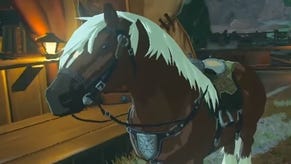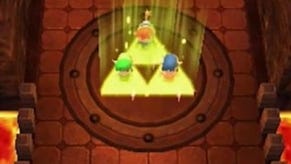The Legend of Zelda: Tri Force Heroes review
When three become one.
One of my all-time favourite local multiplayer experiences occurred a little over ten years ago, on the solitary occasion in my life when enough Game Boy Advances and Link Cables had been gathered together with a GameCube for a full four-player session on Nintendo's magnificent co-op romp, The Legend of Zelda: Four Swords Adventures. Magnificent, but now near-forgotten, because the hardware barrier to entry to experience Four Swords Adventures as it was intended to be played was set so unrealistically high. It was as rarefied a mid-2000s gaming delight as a go on a Samba de Amigo set-up that actually worked.
Multiplayer Zelda is one of Nintendo's great, unrealised ideas. Unrealised not because Nintendo's designers lack the skill or imagination to create it - there's been an entertaining template in existence since 2002, when Four Swords debuted as a multiplayer add-on for the GBA version of the classic A Link to the Past. It's unrealised because Nintendo has never managed to hook it up with the right technology and bring players along for the ride. It has become elusive to the extent that an excellent Four Swords remake by Grezzo for DSi and 3DS was released for a limited time only a few years ago. If you didn't grab it, it was gone.
Tri Force Heroes for 3DS is Nintendo's latest swing at making multiplayer Zelda a reality - for three players this time - and, thanks to an online mode as well as generous local multiplayer options, it's the most accessible yet. But there's still a chance that history will record it as another near-miss.
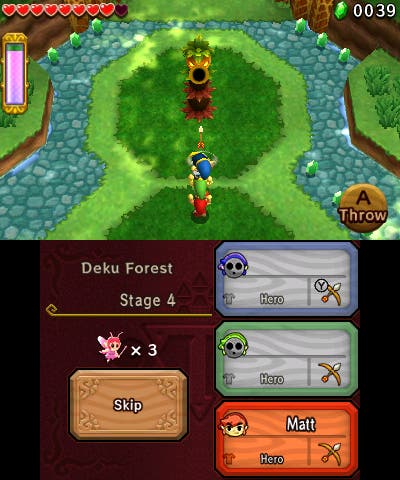
Like Four Swords before it, Tri Force Heroes is built on the old-school, top-down style of Zelda - in this case, 2013's A Link Between Worlds, which furnishes its slick game engine, chunky little models and bright, toylike aesthetic. Also like Four Swords, its structure is far more simple and conventional than the intricate sprawl of a solo Zelda adventure, breaking the action into a straight series of levels: eight zones of four levels each, each level further divided into four consecutive stages.
This is Zelda concentrate. You don't get that interlocking, unfurling sense of progression as the map opens both outwards and inwards in line with your abilities; you can only use the items each level provides you with. But don't take concentrated to mean simplified. These are tightly constructed action canapés that run the full gamut of puzzle-solving, exploration, navigational challenges, frantic combat and elaborate boss battles - often possessing the systematic grace and mechanical wit that are synonymous with the Zelda name. They don't mess around, either. This is quite a tough game.
You don't get much of a story; indeed, Tri Force Heroes seems to revel in its non-canonical frivolity. This isn't Hyrule but Hytopia, a preening, fashion-conscious realm where the greatest peril that has befallen its princess, Styla, is to be cursed by a wicked witch with having to wear an unflattering onesie. Off our hero sets - or rather, heroes, as the game implies that scores of youths with pointy ears are being rounded up and sent to their doom, in a sly send-up of Zelda's traditional chosen-one narrative - into the dangerous and unstylish Drablands to try to lift the curse, so the princess can stand to look at herself in the mirror again.
It's all surface, deliberately so, and pulled off with considerable charm over a wonderful soundtrack of wheezing accordions, harrumphing trombones, trilling sopranos and dancing fiddles. The stakes are low and we're in this for the larks. Tri Force Heroes knows it's not a real Zelda game, and it's not just comfortable with that, it's having fun with it.
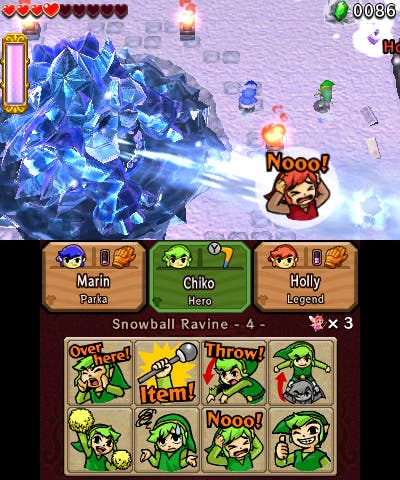
Like Four Swords, it's all about a quick scramble through each level, pulling our three Links together to collaborate in ways that go far beyond the simple mechanics (dual switches, double damage) of other co-op games. Tri Force Heroes is even more focused, with levels that seldom allow the players to stray far from one another, and a shared health pool that really concentrates the mind on teamwork and discourages the cheeky, rough-and-tumble competitive edge that Four Swords had. Then there's the totem gimmick, which allows the players to stand on each other's shoulders, and around which many of the puzzles and combat encounters revolve. With one player operating the feet and another the hands, it's quite a coordination challenge.
The game is entirely designed around three heroes, and impossible to play with more or less. What this means for solo play is that you head into a stage in the company of two 'doppels': creepy, gape-mouthed mannequins. You can switch between control of the doppels with a tap of the touchscreen, but when not controlled, they're totally inert, and the quickest way to get around is simply to carry them in a totem stack. It's impressive that the game has been designed to be completely playable this way - even with the testing bonus challenges active, it's impossible to break it, and every obstacle can be overcome.
But it's not much fun. Playing Tri Force Heroes solo is finicky and halting. When good timing is necessary, it's actively aggravating. There's still satisfaction to be had from teasing out the puzzles - and sometimes, an extra layer of puzzle-solving in figuring out how to manage it alone - but as a purely single-player game, I can't recommend it. Once there were enough players online this week that I wouldn't need to play it alone again, I never looked back.
Local multiplayer is probably the most straightforward way to enjoy the game - if not exactly easy to organise - and it's well supported by a generous Download Play option that allows three players to experience almost the entire thing on just one copy, with minor restrictions. Played with friends, Tri Force Heroes recaptures the knockabout, quarrelsome spirit that I so loved in Four Swords Adventures, and as mentioned, it's hard - or rather, it's quick to punish players who aren't in sync with each other. It's hard because true co-operation is hard, and Tri Force Heroes is entirely about that kind of co-operation (rather than merely reserving it for endgame challenges, as so many co-op games do). At any rate, there's a real joy to be had from figuring out a level together and besting it with smooth teamwork moves.
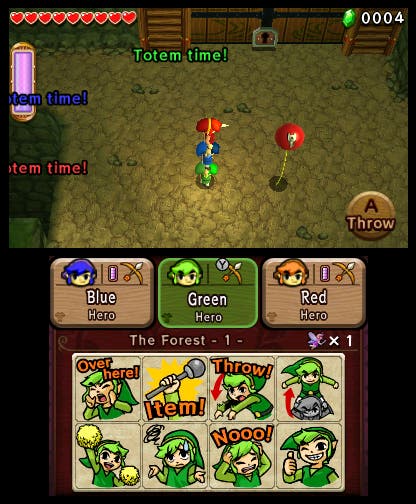
And played with strangers online? It's almost better. With no chat function, communication is severely hampered, although Nintendo furnishes you with a suite of handy and playfully implemented emotes on the touch screen - over here, use your item, pick me up, thumbs up, sorry, yay. It becomes part of the game to unpick the game's challenges together using this tiny vocabulary, and when you do establish a wordless bond with two total strangers, it's a great feeling. Occasionally, though, the challenges are just too involved for this system, and you find yourself furiously and fruitlessly screaming some puzzle solution at the screen - or scratching your head in clueless guilt, knowing that somewhere out there, you are being screamed at.
Still, in real-world terms, it's as an online game that Tri Force Heroes makes the most sense. It's not huge, but it's perfect for dipping into and designed around robust replayability. Though puzzle solutions are obviously fixed, most of them require a level of deft teamwork to pull off - and each level can be played with various bonus challenges active that really ramp up the difficulty, from time limits, to energy or health debuffs, to keeping all three heroes within a tight radius at all times. A tidy feedback loop has been set up between these and the costume-crafting metagame that's behind all the fashion talk.
The costumes, which might dress Link up as a Zora or as Zelda, are made using materials awarded at the end of each level, and are adorable and camp enough to be worth collecting just for their looks. But each also confers a useful bonus, which might be general (more health, a chance to evade, swim in lava) or specific to certain items. There's an art to selecting the right costume for the right stage, especially with bonus challenges active - and of course, bonus challenges also reward better materials for costume crafting. Combine these complementary incentives to dot around the game's levels with the element of fresh unpredictability brought by other players - and the element of chance involved in getting the loot you want - and Tri Force Heroes can be a surprisingly rewarding online grind, a sort of miniaturised MMO.
While not a total success, in its way Tri Force Heroes is as unique an online gaming experience as the brilliant Splatoon. Nintendo has come at online gaming desperately late, but from such unusual angles - and with such inventive disregard for multiplayer convention - that it can still stop you in your tracks. The best thing I can say about Tri Force Heroes is that there isn't another co-op game out there like it. The worst - assuming we're not keeping up the pretence that it is in any way a single-player game, because as such, it's a failure - is that it can sometimes be its own worst enemy. If you're lucky enough to have two friends you can reliably play it with, it's a sure shot. If you don't, you can take your chances online and see if that mercurial delight that is multiplayer Zelda - still evasive after all these years - deigns to reveal itself to you. You might be lucky.



